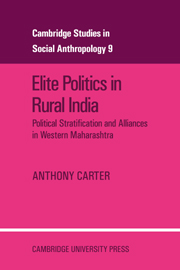 Elite Politics in Rural India
Elite Politics in Rural India from Part 2 - Aspects of political stratification
Published online by Cambridge University Press: 02 March 2010
It remains to demonstrate in what manner ties of kinship enter into political stratification. v∂t∂ndar Marathas, the predominant element of the political class of rural Western Maharashtra, are linked to the non-v∂t∂ndar Marathas, the largest section of the population falling outside the political class, by common Maratha caste identity. In principle, therefore, there is no reason why the two sections of the Maratha caste cannot be related also by ties of kinship and marriage which might either permit v∂t∂ndar to call upon their non-v∂t∂ndar relatives for support or permit the latter to make claims upon the former for patronage. In fact, however, ties of kinship and marriage link v∂t∂ndar and non-v∂t∂ndar Marathas infrequently and in only a few characteristic forms. Furthermore, v∂t∂ndar may be distinguished from the rest of the Maratha caste by their large corporate descent groups and far flung affinal networks and both of these features of v∂t∂ndar Maratha kinship are a support for their dominant position as well as a product of it. An analysis of political stratification and alliances, therefore, must take into account the networks of kinship ties which are available to elite politicians and also the ways in which such networks are linked to but different from those found among other sections of the population.
Relatives in the most inclusive sense are called natl∂g or natevaik in Marathi. Natevaik are of two kinds, bhauki and soyre. These two categories are mutually exclusive and exhaust the universe of relatives. According to informants bhauki are blood (r∂kt∂) relatives, while soyre are relatives by marriage (l∂gna).
To save this book to your Kindle, first ensure [email protected] is added to your Approved Personal Document E-mail List under your Personal Document Settings on the Manage Your Content and Devices page of your Amazon account. Then enter the ‘name’ part of your Kindle email address below. Find out more about saving to your Kindle.
Note you can select to save to either the @free.kindle.com or @kindle.com variations. ‘@free.kindle.com’ emails are free but can only be saved to your device when it is connected to wi-fi. ‘@kindle.com’ emails can be delivered even when you are not connected to wi-fi, but note that service fees apply.
Find out more about the Kindle Personal Document Service.
To save content items to your account, please confirm that you agree to abide by our usage policies. If this is the first time you use this feature, you will be asked to authorise Cambridge Core to connect with your account. Find out more about saving content to Dropbox.
To save content items to your account, please confirm that you agree to abide by our usage policies. If this is the first time you use this feature, you will be asked to authorise Cambridge Core to connect with your account. Find out more about saving content to Google Drive.